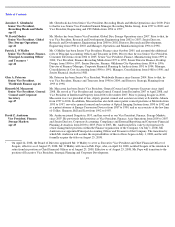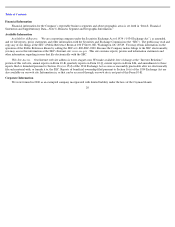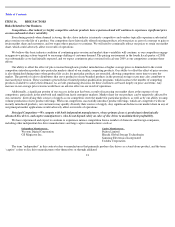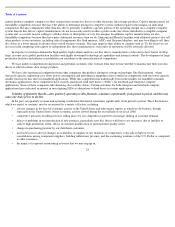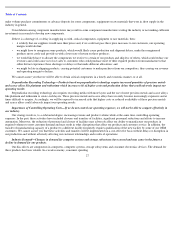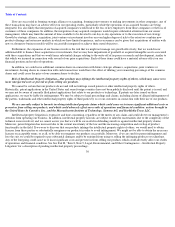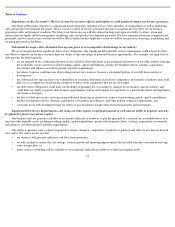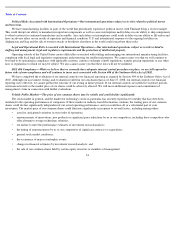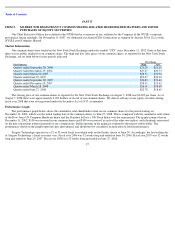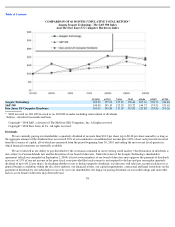Seagate 2007 Annual Report Download - page 30
Download and view the complete annual report
Please find page 30 of the 2007 Seagate annual report below. You can navigate through the pages in the report by either clicking on the pages listed below, or by using the keyword search tool below to find specific information within the annual report.
Table of Contents
Impact of Technological Change—Increases in the areal density of disc drives may outpace customers’ demand for storage capacity.
The rate of increase in areal density, or storage capacity per square inch on a disc, may be greater than the increase in our customers
’
demand for aggregate storage capacity, particularly in certain market applications like commercial desktop compute. As a result, our customers’
storage capacity needs may be satisfied with lower priced, low capacity disc drives. These factors could decrease our sales, especially when
combined with continued price erosion, which could adversely affect our results of operations.
Changes in Electronic Data Storage Products—Future changes in the nature of electronic data storage products may reduce demand
for traditional disc drive products.
We expect that in the future, new personal computing devices and products will be developed, some of which, such as Internet appliances,
may not contain a disc drive. While we are investing development resources in designing disc drives for new applications, it is too early to assess
the impact of these new applications on future demand for disc drive products. Products using alternative technologies, such as flash memory,
optical storage and other storage technologies could become a significant source of competition to particular applications of our products, which
could adversely affect our results of operations.
New Product Development and Technological Change—
If we do not develop products in time to keep pace with technological changes,
our operating results will be adversely affected.
Our customers have demanded new generations of disc drive products as advances in computer hardware and software have created the
need for improved storage products, with features such as increased storage capacity, improved performance and reliability and lower cost. We,
and our competitors, have developed improved products, and we will need to continue to do so in the future. Such product development requires
significant investments in research and development. We cannot assure you that we will be able to successfully complete the design or
introduction of new products in a timely manner, that we will be able to manufacture new products in sufficient volumes with acceptable
manufacturing yields, that we will be able to successfully market these new products or that these products will perform to specifications on a
long-term basis. In addition, the impact of slowing areal density growth may adversely impact our ability to be successful.
When we develop new products with higher capacity and more advanced technology, our operating results may decline because the
increased difficulty and complexity associated with producing these products increases the likelihood of reliability, quality or operability
problems. If our products suffer increases in failures, are of low quality or are not reliable, customers may reduce their purchases of our products
and our manufacturing rework and scrap costs and service and warranty costs may increase. In addition, a decline in the reliability of our
products may make us less competitive as compared with other disc drive manufacturers or competing technologies.
Risks Associated with Future Strategic Alliances, Joint Ventures or Investments—We may not be able to identify suitable strategic
alliances, acquisitions, joint ventures or investment opportunities, or successfully acquire and integrate companies that provide
complementary products or technologies.
Our growth strategy may involve pursuing strategic alliances with, and making acquisitions of, forming joint ventures with, or investments
in, other companies that are complementary to our business. There is substantial competition for attractive strategic alliance, acquisition, joint
venture and investment candidates. We may not be able to identify suitable acquisition, joint venture, investment or strategic partnership
candidates. Even if we were able to identify them, we cannot assure you that we will be able to partner with, acquire or invest in suitable
candidates, or integrate acquired technologies or operations successfully into our existing technologies and operations. Our ability to finance
potential strategic alliances, acquisitions, joint ventures or investments will be limited by our high degree of leverage, the covenants contained in
the indentures that govern our outstanding indebtedness, the credit agreement that governs our senior secured credit facilities and any agreements
governing any other debt we may incur.
29


